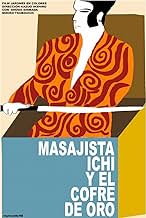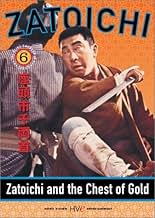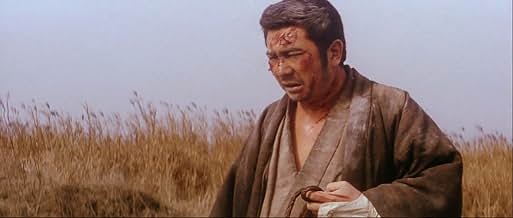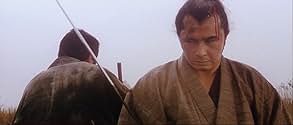VALUTAZIONE IMDb
7,3/10
1948
LA TUA VALUTAZIONE
Aggiungi una trama nella tua linguaZatoichi is mistaken for a thief. To clear his name he must find and defeat the real villain.Zatoichi is mistaken for a thief. To clear his name he must find and defeat the real villain.Zatoichi is mistaken for a thief. To clear his name he must find and defeat the real villain.
- Regia
- Sceneggiatura
- Star
Tomisaburô Wakayama
- Jûshirô
- (as Jo Kenzaburo)
Kenjirô Uemura
- Gundayu Matsui
- (non citato nei titoli originali)
Recensioni in evidenza
This one has my favourite intro of the Zatoichi series. It's incredibly stylish with Ichi slaying numerous groups of hostile samurai in the darkness. The way this chapter of Ichi's saga is told was indeed a welcome change to the visuals and storyboarding, which I felt had stagnated in the previous two films. The plot resonates deeply too. Corruption is the theme of this tale, and of course our hero has to sort this mess out by unleashing some calculated chaos upon the twisted fiends in authority. It would be great if things worked like that in the real world. Maybe if each of us were a little more like Ichi, then one day... who knows.
The Zatoichi series really took off with this entry. Shintaro Katsu is, of course, outstanding in his role as the blind swordsman/masseur. What sets this one aside from the earlier entries in the series, though, is the kinetic camerawork of Kazuo Miyagawa. Utilising every inch of his Panavision frame, Miyagawa set new standards for the samurai genre, choreographing outstanding fight sequences and adding the element of gore to the recipe. For those who think widescreen mayhem began with The Wild Bunch, this is essential viewing!
Zatoichi and the Chest of Gold is one of the most exciting - and exasperating - installments in the series.
The plot is rich in incident and characters. After rural farmers pay their taxes, a corrupt magistrate and his cronies steal the gold, and leave the farmers desperate for a solution. Zatoichi finds himself in the middle of the problem. On one hand, he's pressured by the farmers, who suspect Zatoichi might have participated in the heist...and on the other, the burglary is pinned onto a cadre of honorable yakuza in a secluded hideout.
The story has a few "firsts" for the Zatoichi series. Earlier installments were bloodless, but ZATCOG shows violence for the first time - mostly with a sprinkling of fake blood. It's also the first chance for Zatoichi to develop a truly comic incident - when a smelly, less-than-competent masseuse serves him - then overcharges him.
The most problematic "first" relates to the filmmaking style. Instead of the restrained style of the first few Zatoichi films, ZATCOG uses looser editing and sound than before. Visual edits use slapdash jump cuts that are closer in spirit to the LONE WOLF AND CUB series. Faked visual and sound effects marred less several extended sequences. The most embarrassing sequence has Zatoichi carrying a little boy - clearly a dummy - on his shoulders as he slides down a ridge.
At the least, ZATCOG comes up a bunch of new situations and characters to invigorate the series - even if the director, Kazuo Ikehiro, is less than proficient at this job.
The plot is rich in incident and characters. After rural farmers pay their taxes, a corrupt magistrate and his cronies steal the gold, and leave the farmers desperate for a solution. Zatoichi finds himself in the middle of the problem. On one hand, he's pressured by the farmers, who suspect Zatoichi might have participated in the heist...and on the other, the burglary is pinned onto a cadre of honorable yakuza in a secluded hideout.
The story has a few "firsts" for the Zatoichi series. Earlier installments were bloodless, but ZATCOG shows violence for the first time - mostly with a sprinkling of fake blood. It's also the first chance for Zatoichi to develop a truly comic incident - when a smelly, less-than-competent masseuse serves him - then overcharges him.
The most problematic "first" relates to the filmmaking style. Instead of the restrained style of the first few Zatoichi films, ZATCOG uses looser editing and sound than before. Visual edits use slapdash jump cuts that are closer in spirit to the LONE WOLF AND CUB series. Faked visual and sound effects marred less several extended sequences. The most embarrassing sequence has Zatoichi carrying a little boy - clearly a dummy - on his shoulders as he slides down a ridge.
At the least, ZATCOG comes up a bunch of new situations and characters to invigorate the series - even if the director, Kazuo Ikehiro, is less than proficient at this job.
The Zatoichi series take a huge jump upward with this entry. Everything also falls into line -- you can tell people in front of and behind the camera had really hit their stride.
This film offers more action that the previous entries, as well as stunning cinematography and gorgeous production values. Another bonus -- the appearance of Katsu Shintaro's real-life older brother, Wakayama Tomisaburo. It's as if the box office performance of the previous films justified bringing out the big guns this time.
If you're new to Zatoichi and wondering with which film to take the plunge, then "Chest of Gold" is definitely worth your time.
This film offers more action that the previous entries, as well as stunning cinematography and gorgeous production values. Another bonus -- the appearance of Katsu Shintaro's real-life older brother, Wakayama Tomisaburo. It's as if the box office performance of the previous films justified bringing out the big guns this time.
If you're new to Zatoichi and wondering with which film to take the plunge, then "Chest of Gold" is definitely worth your time.
10inframan
I think this stunning film ranks among the great action films of all time but could be hung as stills in any art museum. Hokusai & Hiroshige influences abound.
Yet best of all is the unforgettable character Zatoichi himself. Shintaro Katsu created an everyman/superhero who had no equal, at least in western culture. A squat, homely, bandy-legged self-deprecating blind man full of humor & humility & an abundance of spirituality. And could he make that sword dance.
These movies have no equal. Each one is as perfectly made as any movie can be. I used to go see them when they first appeared in the theaters of San Francisco & Los Angeles Japanese neighborhoods. I still love them every bit as much now.
Yet best of all is the unforgettable character Zatoichi himself. Shintaro Katsu created an everyman/superhero who had no equal, at least in western culture. A squat, homely, bandy-legged self-deprecating blind man full of humor & humility & an abundance of spirituality. And could he make that sword dance.
These movies have no equal. Each one is as perfectly made as any movie can be. I used to go see them when they first appeared in the theaters of San Francisco & Los Angeles Japanese neighborhoods. I still love them every bit as much now.
Lo sapevi?
- QuizJushiro is played by Shintarô Katsu's real-life brother, Tomisaburô Wakayama, who would later star in the Lone Wolf and Cub series of films (produced by Katsu).
- ConnessioniFeatured in Best in Action: 1964 (2020)
I più visti
Accedi per valutare e creare un elenco di titoli salvati per ottenere consigli personalizzati
- How long is Zatoichi and the Chest of Gold?Powered by Alexa
Dettagli
- Data di uscita
- Paese di origine
- Lingua
- Celebre anche come
- Zatoichi and the Chest of Gold
- Azienda produttrice
- Vedi altri crediti dell’azienda su IMDbPro
- Tempo di esecuzione
- 1h 23min(83 min)
- Proporzioni
- 2.35 : 1
Contribuisci a questa pagina
Suggerisci una modifica o aggiungi i contenuti mancanti





























